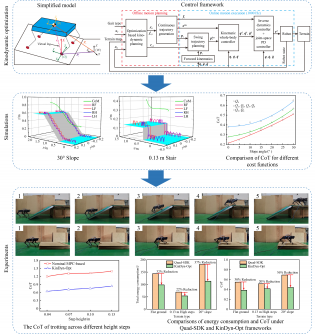Science
Quadrupedal Robots Optimized for Challenging Terrain Navigation

Recent advancements in the field of quadrupedal robotics have led to the development of a novel kinodynamic optimization approach aimed at improving navigation across challenging terrains. Researchers Qi Li, Lei Ding, and Xin Luo have tackled the complex issues faced by quadrupedal robots, particularly when traversing steep slopes and uneven surfaces. Their findings, published in the Journal of Robotics, highlight the limitations of traditional motion planning methods and propose innovative solutions to enhance robot locomotion performance.
Addressing Navigation Challenges
Conventional quadrupedal robots often struggle with dynamic motion planning, particularly on irregular terrains. Typically, these robots generate coarse motion plans and rely on reactive strategies to adapt to unforeseen obstacles. This reactive approach can result in non-optimal movements, disrupting the robot’s locomotion rhythm and efficiency.
The study identifies several critical challenges in existing motion planning methods. For instance, traditional techniques tend to separate foothold selection from torso motion planning, complicating the adherence to joint limits and collision avoidance. Additionally, short-horizon optimization methods fail to maintain rhythmic movement over extended periods, while offline trajectory optimization lacks real-world performance validation regarding torso movement smoothness and energy efficiency.
Innovative Kinodynamic Optimization Approach
To overcome these challenges, the researchers propose a comprehensive optimization framework that treats the feet’s positions, contact forces, and torso motions as interdependent variables. By framing motion planning as an optimization problem, the study seeks to minimize energy consumption while ensuring smooth movement. The approach incorporates terrain information to establish feasible foothold regions and friction constraints, significantly enhancing the robot’s adaptability.
The researchers employed an anteroposterior sequence (APS) parameterization to effectively describe gait patterns. This method allows for the determination of each leg’s contact state at any given moment. A simplified dynamic model characterizes the robot’s main dynamics, treating it as a rigid torso connected to four massless virtual legs. This design choice aids in managing the robot’s movement across various terrains.
Key constraints are imposed within the optimization framework to ensure the feasibility of motion. Kinematic constraints limit foothold positions within a designated workspace, while contact constraints ensure compliance with terrain push requirements and Coulomb friction rules. Furthermore, terrain constraints align the foothold z-position with the terrain height, enforcing no-slip conditions to maintain stability during locomotion.
This innovative kinodynamic optimization approach represents a significant leap forward in the field of quadrupedal robotics, addressing the limitations of traditional methods and enhancing the ability of robots to navigate challenging environments effectively. The full text of the study is available at https://doi.org/10.1007/s11465-024-0791-5.
-

 World5 days ago
World5 days agoExposing the Reality Behind Guatemala’s Garment Industry
-

 Politics5 days ago
Politics5 days agoLB Pharmaceuticals Quiet Period Ends October 21, Analysts Weigh In
-

 Business5 days ago
Business5 days agoRoyal Bank of Canada Upgrades Ovintiv to Outperform Rating
-

 Sports5 days ago
Sports5 days agoSaquon Barkley Reflects on James Franklin’s Dismissal from Penn State
-

 Health5 days ago
Health5 days agoFDA Announces First Nine Recipients of National Priority Vouchers
-

 World5 days ago
World5 days agoHamas to Return Remains of Additional Hostage on Friday
-

 Science5 days ago
Science5 days agoMIT Develops 3D Brain Models from Patient Cells for Custom Therapies
-

 Entertainment5 days ago
Entertainment5 days agoOlivia Nuzzi’s Memoir Set to Uncover RFK Jr.’s Controversial Texts
-

 Lifestyle3 days ago
Lifestyle3 days agoHistorian Seeks Help to Uncover Cherry Street’s Past
-

 Science3 days ago
Science3 days agoYale School of the Environment Launches Accelerated Master’s Programs
-

 Entertainment5 days ago
Entertainment5 days agoSylvester Stallone’s ‘Alarum’ Surges in Streaming Despite Poor Reviews
-

 Lifestyle5 days ago
Lifestyle5 days agoSouth Los Angeles Intersection Renamed to Honor Activist Danny Bakewell Sr.







